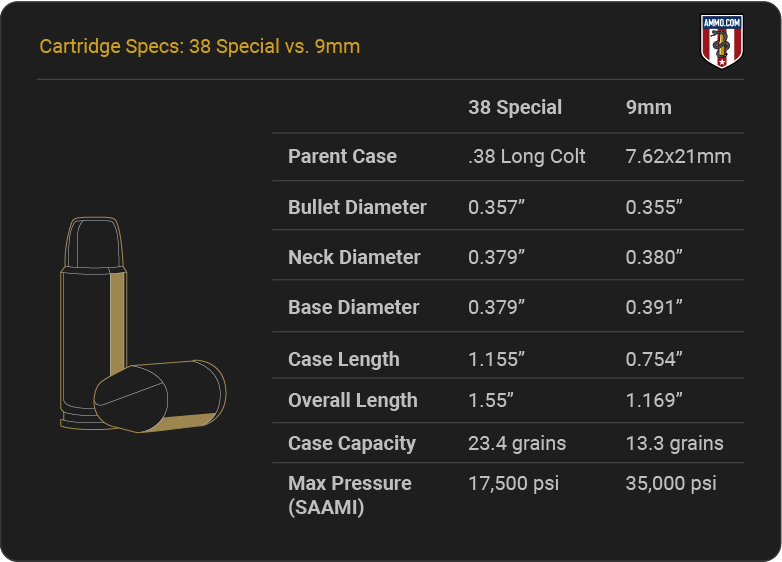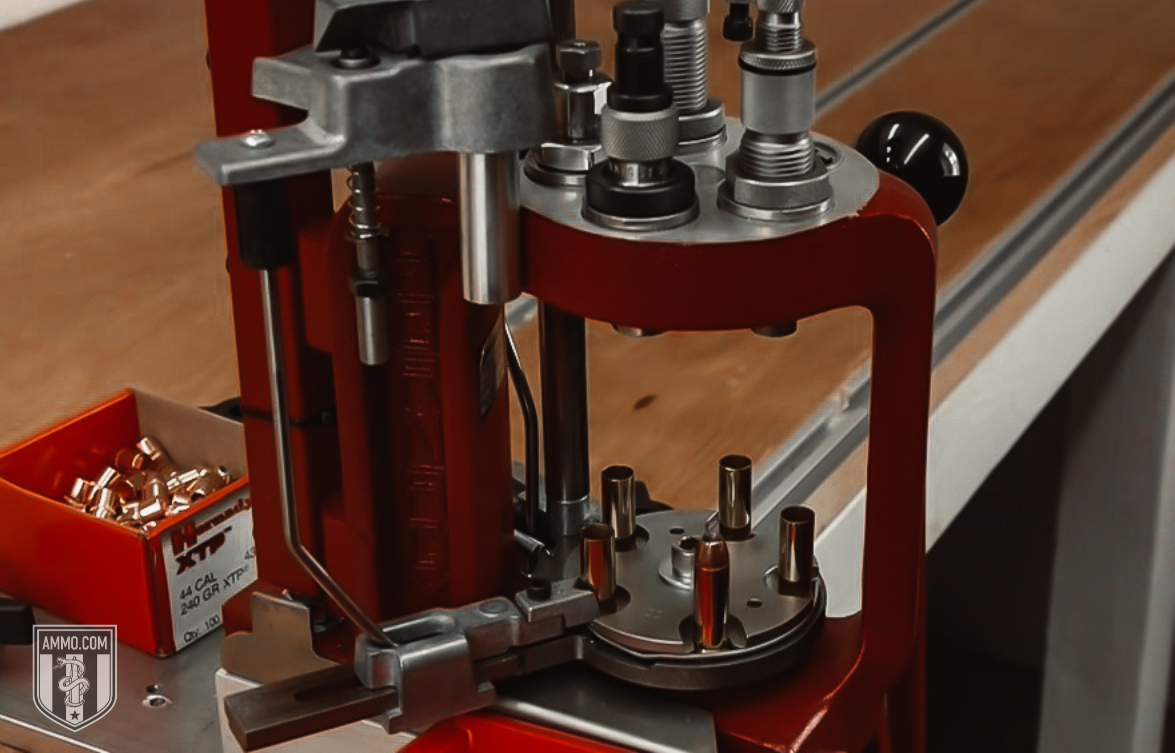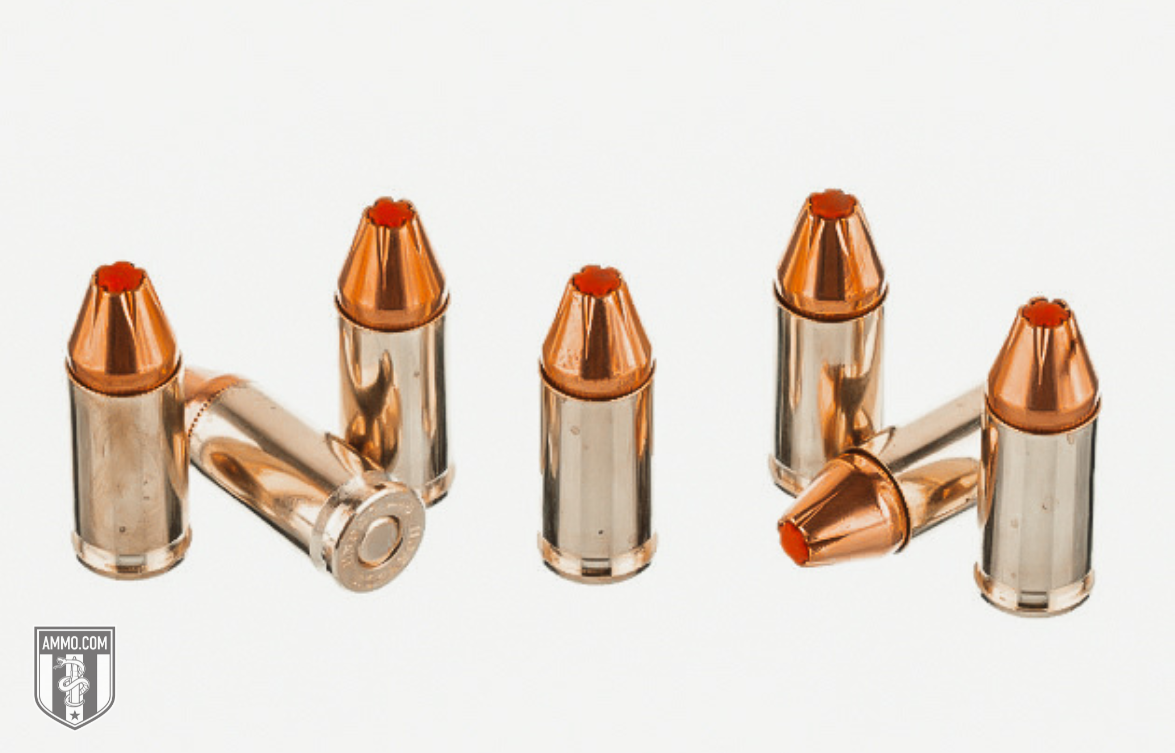38 Special vs. 9mm: Is It Even Worth Debating?
 Thanks to their bullets, the 9mm Luger and 38 Special might seem similar to new shooters, but the two rounds have differing capabilities. The 9mm is often the best choice for self-defense for several reasons, which we shall discuss in our 38 Special vs. 9mm battle below.
Thanks to their bullets, the 9mm Luger and 38 Special might seem similar to new shooters, but the two rounds have differing capabilities. The 9mm is often the best choice for self-defense for several reasons, which we shall discuss in our 38 Special vs. 9mm battle below.
Let’s get started!
38 Special vs. 9mm
The 38 Special was designed for use in revolvers over 100 years ago. It’s still a favorite of many shooters for various shooting applications.
I’ve fired my grandpa’s 38 Spl snub-nosed revolver many times at the range. I always found it very enjoyable, and preferable to his 357 Magnum revolver.
The 9x19mm Parabellum (aka 9x19mm NATO, 9mm Luger, or 9mm) was also designed over 100 years ago by Georg Luger. However, it didn’t take off in the U.S. until the 1980s and 1990s, when reliable semi-automatic pistols used by law enforcement agencies, such as the FBI, were developed.
I own multiple 9mm handguns. One is a revolver that uses moon clips. The rest are semi-auto pistols, any of which I would trust for personal protection and home defense.
After briefly comparing the cartridges’ specifications, we will see how these rounds fare in terms of recoil, trajectory, accuracy, stopping power, and several other factors. Upon tallying the winners in each section, we’ll decide which is best for your situation.
Cartridge Specs: 38 Special vs. 9mm

The 38 Spl and the 9mm appear to have similar characteristics to the untrained eye. As you can see from the chart, however, they have a few key identifying factors to distinguish the two. One giveaway for the 9mm cartridge is that it’s rimless, which helps it cycle better through semi-auto handguns. This also means you need moon clips to use it in a revolver.
The two most significant differences between these cartridges are the case length and maximum pressure. The 38 Spl’s case is 0.401” longer than the 9mm’s and has a larger capacity by 10.1 grains. However, 9mm rounds have double the maximum pressure of 38 Special rounds according to SAAMI specs.
These rounds also have similar bullet weights. The most common for a 9mm is a 115 grain bullet, but it generally ranges from 53 grains to 165 grains. The 38 Special typically ranges from 90 to 158 grains, with 158 grains being one of the most popular bullet weights.
Since both of these cartridges were designed for handguns, one might assume they perform identically in the real world. Let’s find out if that assumption is correct.
Recoil

Recoil is always a touchy topic because it’s never equal when comparing two cartridges. Recoil is determined by many factors, including the firearm’s weight, bullet weight, and muzzle velocity.
A snub-nose revolver will typically have more felt recoil than a semi-auto pistol because snubbies don’t have all the recoil-absorbing mechanisms that semi-auto pistols typically do, such as the spring and slide, which help to “absorb” some of the felt recoil.
All things considered as equal as possible, the 38 Special will have less recoil than the 9mm because of its lower pressure (therefore lower velocity). You can expect 2.6 to 3 pounds of felt recoil from the 38 Spl, whereas the 9mm has 4 to 8 pounds of recoil.
The 38 Special is off to a great start. But can it maintain its lead?
Trajectory
If you’re using these cartridges for concealed carry, you won’t notice enough difference in their trajectory to affect your choice since most self-defense situations happen within 25 yards. However, it’s important to remember that barrel length significantly contributes to trajectory. When firing the same round, a short barrel will produce a worse trajectory than a longer one.
Bullet design also plays a significant role in trajectory, although it’s less evident at short ranges than when shooting long range. But for the sake of the argument, the 9mm will generally have a slightly flatter trajectory than the 38 Spl due to the higher velocities of its similarly weighted projectiles.
Accuracy
Once again, many factors affect a round's accuracy. The shooter’s capabilities, recoil, trajectory, and firearm are all significant factors that must be considered.
A skilled marksman can be accurate with nearly any round and firearm. While I’m proficient with most handguns, I tend to be most accurate with my 9mm semi-auto pistols. This is likely because I often fire them instead of a 38 Special revolver. That’s just me, though. I’m certain there are 38 Special masters out there who can shoot circles around me.
To be as fair as possible, we will judge it based on recoil and trajectory. Recoil doesn’t only affect follow-up shots, as some believe to be true. It also plays a significant role in the initial shot. Many shooters will flinch when firing heavy recoil rounds in anticipation of the recoil, which makes them less accurate.
Since these categories were split between the two cartridges, we shall consider this one a draw. The 38 Special will likely be more accurate for the recoil-sensitive shooter, whereas the 9mm might be more accurate for those who are used to firing semi-automatic pistols.
Stopping Power
To be clear, both cartridges have enough “stopping power” to be effective for self-defense, as proper shot placement is the most critical factor in any argument regarding stopping power. Stopping power is influenced by bullet design, energy, and velocity. For instance, a 115-grain jacketed hollow point (JHP) bullet will have more stopping power than a 124-grain full metal jacket (FMJ) bullet.
Stopping power is subjective. But if you’re wondering if the 38 Special is more powerful than the 9mm, then the answer is no.
Even though it’s smaller, the 9mm is more powerful because of its higher chamber pressure. That propels its projectile to a higher velocity, thus increasing its potential striking energy in turn.
The 9mm takes this category and the lead.
Ammo and Handgun Cost/Availability
The 9mm is one of the most popular handgun cartridges in the world, which means ammo and firearms are readily available at most American retailers (including Ammo.com).
That doesn’t mean 38 Special ammo and firearms are difficult to find. They’re not. We have many options for 38 Special rounds in stock!
9mm ammo tends to be less expensive per round, and you generally have more options regarding bullet design, weight, pressure preference, and brand.
If you're on a tight budget, purchasing a 9mm will likely mean you'll go to the shooting range more often.
The 9mm’s wider variety and better pricing win this section.
Reloading

For reloaders wondering if the cartridges can be reloaded, the simple answer is a resounding yes!
I own a Lee Precision Ultimate Turret Press to reload my 9mm, and my grandpa reloads 357 Magnum, 45 ACP, and 38 Special on his Dillion reloader.
There is a plethora of reloading information and materials available for both cartridges, so this section is a draw.
9mm vs. .38 Special Ballistics
On paper, the 9mm outperforms the .38 Spl every day of the week, which is one reason so many shooters love it.
That doesn’t mean it’s the right choice for you. You might enjoy firing the 38 Spl despite its ballistic setbacks.
9mm Ballistics

Administrative Note: The information above comes from the manufacturers. The actual ballistics obtained with your firearm can vary considerably from advertised ballistics. Ballistic performance can also vary from lot to lot, even with the same brand and label. When manufacturer ballistic data was unavailable, ballistics were calculated using a ballistics calculator.
For a comprehensive look at the performance of different 9mm rounds, explore our detailed guide on 9mm ballistics, which covers the ballistics data from all the popular ammo manufacturers.
Check out our 9mm ballistics charts for a deeper dive into every 9mm round.
.38 Special Ballistics

Administrative Note: The information above comes from the manufacturers. The actual ballistics obtained with your firearm can vary considerably from advertised ballistics. Ballistic performance can also vary from lot to lot, even with the same brand and label. When manufacturer ballistic data was unavailable, ballistics were calculated using a ballistics calculator.
9mm History
The 9x19mm Luger was designed by the Austrian gunsmith Georg Luger in 1901. He derived it from the 7.65x21mm Parabellum.
In 1903, the U.S. military considered the 9 mm, as well as Browning’s 45 ACP. The 9mm was not adopted by the U.S. military until much later, although the German Imperial Navy and Army adopted it in 1904 and 1908, respectively.
After World War I and through World War II, the 9mm became one of Europe's most popular handgun cartridges. The United States clung to the maxim “bigger bullets are better” until the U.S. Army adopted the Beretta M9 Service Pistol in the 1980s.
Since this adoption, the 9mm has become synonymous with law enforcement and home defense thanks to its high magazine capacity, stopping power, and low cost per round.
.38 Special History
Smith & Wesson introduced the 38 Special (aka 38 S&W Special, 38 Smith & Wesson Special, 38 Spl, 38 Spc, and 9x29mmR) in 1898.
The 38 Spl is a rimmed straight-wall centerfire handgun cartridge developed for high velocity (at the time), increased penetration, and stopping power. It originally utilized black powder as its propellant, but manufacturers switched to smokeless powder within a year of development.
The 38 Special round was originally loaded with 21 grains of black powder and offered shooters a 100-150 fps increase in muzzle velocity over the parent case (38 Long Colt). The switch to smokeless powder left a lot of unused space inside the case, as smokeless powder needs less volume to achieve appropriate pressures. This is why many reloaders and wildcatters pushed the 38 Special to its limits.
Elmer Keith was the reloader who developed the 357 Magnum from the 38 Special.
Although the 38 Special was not the primary U.S. sidearm cartridge for long until it was replaced by the 45 ACP, it was issued to various military personnel during WWI, WWII, Korea, and Vietnam. From the 1920s through the 1990s, the 38 Spl was the standard sidearm cartridge for most U.S. law enforcement departments.
The 38 Special is no longer a standard issue by the military or law enforcement agencies; numerous recreational and competitive shooters still favor it. Thanks to its low recoil and versatility of bullet choices, the 38 Special is ideal for Cowboy Action Shooting, target shooting, and USPSA competition.
Frequently Asked Questions
The team at Ammo.com has gathered and answered some of the most commonly asked questions regarding 38 Special vs. 9mm.
Is a .38 bigger than a 9mm?
Yes, the .38 is bigger than the 9mm in terms of bullet diameter by 0.002 in..
Is 38 Special OK for self-defense?
Yes, the 38 Special is OK for self-defense, though better options exist.
How Available is 9mm Luger Ammo?
9mm Luger ammo is ubiquitous.
Parting Shots: 38 Special vs. 9mm
Whether you’re firing a Glock, Remington, or Winchester pistol, the 9mm will outperform the 38 Special in most circumstances. If you kept track of which cartridge won each section, you’d know that the 38 Special won one section (it has lower recoil), whereas the 9mm won three sections (trajectory, stopping power, and availability), with two sections remaining a tie (accuracy and reloading ability).
I'm sticking with the 9mm, but my wife prefers the 38 Special. Whichever cartridge you choose, Ammo.com has plenty of ammo in stock to meet all your needs!
Ammo Comparisons
- .308 vs 5.56
- 6.5 Creedmoor vs .308
- .300 Blackout vs .308
- .300 Win Mag vs .308
- .243 vs .308
- .308 vs .30-06
- 7mm-08 vs .308
- .270 vs .308
- 7.62x39 vs .308
- .223 vs .308
- .338 Lapua vs .308
- .380 ACP vs 9mm
- .223 vs 5.56
- .300 Blackout vs 5.56
- 9mm vs 45 ACP
- 9mm vs 40 S&W
- .357 SIG vs 9mm
- 10mm vs 9mm
- 9mm vs 9mm Luger
- .243 vs .270
- .300 Win Mag vs .30-06
- .270 vs .30-06
- .40 vs .45
- 38 Special vs 357
- 9mm vs 40 vs 45
- 5.56 vs 7.62x39
- 338 Lapua vs .30-06
- .30-30 vs .30-06
- 300 PRC vs 338 Lapua
- .30-06 vs 7mm
- 300 Win Mag vs 338 Lapua
- 300 PRC vs 300 Win Mag
- 300 WSM vs 300 Win Mag
- 338 Win Mag vs 338 Lapua
- 12 Gauge vs 20 Gauge
- 10mm vs 357 Mag
- .30-30 vs 7.62x39
- 224 Valkyrie vs 22-250
- 17 HMR vs 22 Mag
- 7.62x39 vs .300 Blackout
- 45 ACP vs 45 Auto
- 45-70 vs 30-30
- 300 Blackout vs 223
- 357 Magnum vs 9mm
- 350 Legend vs 300 Blackout
- 224 Valkyrie vs 223
- 45 ACP vs 38 Super
- 6.5 Grendel vs .308
- 17 HMR vs 22 LR
- 10 Gauge vs 12 Gauge
- 22-250 vs 223
- 45 Colt vs 45 ACP
- 350 Legend vs 30-30
- 5.7x28 vs 223
- 5.7 vs 9mm
- 5.56 vs 5.7
- 22 vs 9mm
- Buckshot vs Birdshot
- 450 Bushmaster vs 308
- 450 Bushmaster vs 223
- Buckshot vs Slug
- 6.5 Grendel vs 5.56 vs 223
- 6mm ARC vs 6.5 Grendel
- 44 vs 45
- 458 SOCOM vs 5.56
- 357 vs 44
- 32 ACP vs 380
- 300 Win Mag vs 338 Win Mag vs 338 Lapua Mag
- 450 Bushmaster vs 458 SOCOM vs 50 Beowulf
- 6mm Creedmoor vs 6.5 Creedmoor
- TMJ vs FMJ
- 44 Special Vs 44 Magnum
- 45 90 vs 45 70
- 6.8 Western vs 6.8 SPC
- 50 Beowulf vs 50 BMG
- 26 Nosler vs 6.5 PRC
- 28 Gauge vs 410
- 6.8 SPC vs 5.56
- 6.8 SPC vs 6.5 Grendel
- 6.8 Western vs 7mm Rem Mag vs .28 Nosler
- 6.8 Western vs 6.5 Creedmoor
- 22 Hornet vs 223
- 6.8 Western vs 6.5 PRC
- .410 vs 12 Gauge
- .410 vs 20 Gauge
- 22 LR vs 22 Mag
- 6mm ARC vs 243
- 7mm-08 vs 270
- 243 vs 6.5 Creedmoor
- Nickel vs Brass Casing
- 204 Ruger vs 223
- 50 Beowulf vs 5.56
- 260 Remington vs 6.5 Creedmoor
- 6mm Remington vs 243
- 28 Nosler vs 300 PRC
- 50 Beowulf vs 50 AE
- 22 Nosler vs 22-250
- 450 Marlin vs 45-70
- 300 Win Mag vs 300 Norma
- 458 SOCOM vs 300 Blackout
- 38-55 vs 45-70
- 22 Hornet vs 22 LR
- 300 Norma vs 338 Lapua
- 338 Lapua vs 50 BMG
- 28 Nosler vs 300 Win Mag
- 28 Nosler vs 6.5 Creedmoor
- 204 vs 22-250
- 458 SOCOM vs 45 70
- 44 40 vs 45 70
- 6.8 SPC vs 6.5 Creedmoor
- 450 Bushmaster vs 30-06
- 7mm Rem Mag vs 300 Win Mag
- 30 Carbine vs 223
- 25-06 vs 30-06
- 26 Nosler vs 28 Nosler
- 16ga vs 12ga
- 30 06 vs 7.62 x54R
- 9mm Makarov vs 9mm Luger
- 350 Legend vs 223
- 30 Carbine vs 5.56
- 6.5x55 vs 6.5 Creedmoor
- 6.5 Creedmoor vs 270 vs 25-06
- M193 vs M855
- 450 Bushmaster vs 458 SOCOM
- 6.5 Grendel vs 6.5 Creedmoor
- 350 Legend vs 5.56
- .277 Fury vs 6.8 SPC
- 277 Fury vs 300 Win Mag
- 10mm vs .45 ACP
- 277 Fury vs 223
- 6.8 SPC vs 300 Blackout
- 6.5 PRC vs 6.5 Creedmoor
- 277 Fury vs 308
- 277 Fury vs 6.5 Creedmoor
- 350 Legend vs 450 Bushmaster
- 277 Fury Vs 5.56 NATO
- 10mm vs 40S&W
- 32 ACP vs 9mm
- 32 Special vs 9mm
- 8.6 Blackout vs 300 Blackout
- 30 Super Carry vs. 9mm
- 5.56 vs 9mm
- .50 Action Express vs 9mm
- 7.62x25 vs. 9mm
- 10mm vs 44 Magnum
- 300 Blackout vs 300 Win Mag
- 6.5 Grendel vs 300 Blackout
- 460 Rowland vs 10mm
- 300 RUM vs 300 PRC
- 300 Norma vs 300 PRC
- 45 GAP vs 45 ACP
- 7mm PRC vs 300 Win Mag
- 300 PRC vs 6.5 Creedmoor
- 300 PRC vs 308
- 357 SIG vs 357 Mag
- 7.62x39 vs 7.62x51
- 243 Win vs 223 Rem
- 30 Nosler vs 300 PRC
- 6.5 Creedmoor vs. 30-06 Springfield
- 450 S&W vs. 44 Magnum
- 6.5 Creedmoor vs. 300 Win Mag
- 454 Cassull vs. 45-70 Govt
- 454 Cassull vs. 44 Mag
- 7.62x54r vs. 308 Winchester
- 22 ARC vs. 223 Rem
- Subsonic vs. Supersonic Ammo

